belt MERCEDES-BENZ SLS AMG GT COUPE 2015 C197 Owner's Manual
[x] Cancel search | Manufacturer: MERCEDES-BENZ, Model Year: 2015, Model line: SLS AMG GT COUPE, Model: MERCEDES-BENZ SLS AMG GT COUPE 2015 C197Pages: 290, PDF Size: 6.24 MB
Page 7 of 290
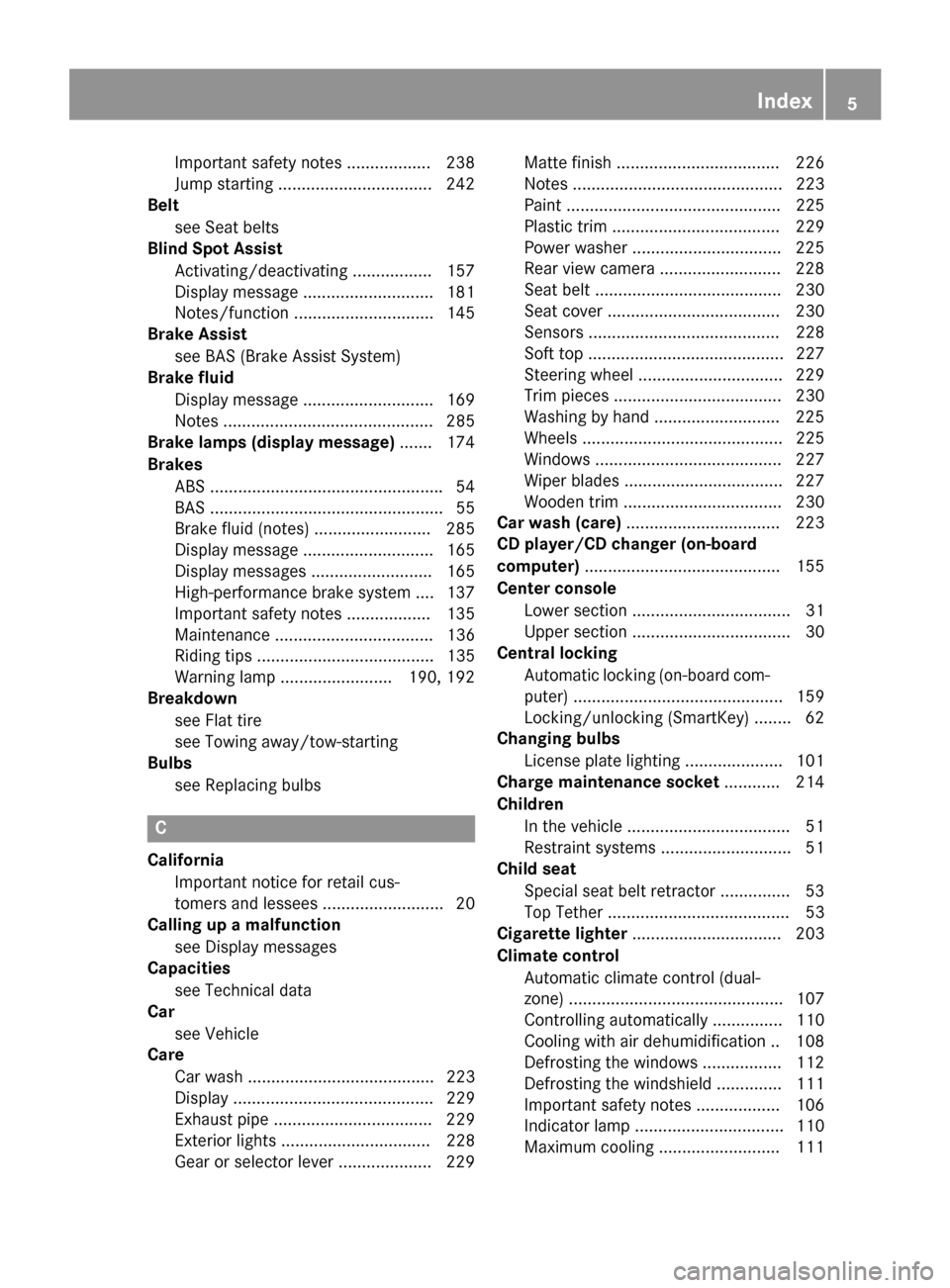
Important safety notes .................. 238
Jump starting .................................2
42
Belt
see Seat belts
Blin dSpot Assist
Activating/deactivating ................. 157
Display message ............................ 181
Notes/function .............................. 145
Brake Assist
see BAS (Brake Assist System)
Brake fluid
Display message ............................ 169
Notes ............................................. 285
Brake lamps (display message) ....... 174
Brakes ABS ................................................. .54
BAS .................................................. 55
Brake fluid (notes) ......................... 285
Displa ymessag e............................ 165
Displa ymessages .......................... 165
High-performance brake system .... 137
Important safety notes .................. 135
Maintenance .................................. 136
Riding tip s...................................... 135
Warning lamp ........................ 190 ,192
Breakdown
see Fla ttire
see Towing away/tow-starting
Bulbs
see Replacing bulbs C
California Important notice for retail cus-
tomers and lessees .......................... 20
Calling up amalfunction
see Displa ymessages
Capacities
see Technica ldata
Car
see Vehicle
Care
Carw ash. ....................................... 223
Displa y........................................... 229
Exhaus tpipe. ................................. 229
Exterior lights ................................ 228
Gear or selector lever .................... 229 Matte finish ................................... 226
Note
s............................................. 223
Paint .............................................. 225
Plastic trim .................................... 229
Power washe r................................ 225
Rear vie wcamera .......................... 228
Sea tbelt. ....................................... 230
Sea tcove r..................................... 230
Sensors ......................................... 228
Soft top .......................................... 227
Steering whee l............................... 229
Tri mp iece s.................................... 230
Washing by hand ........................... 225
Wheel s........................................... 225
Window s........................................ 227
Wipe rblade s.................................. 227
Woode ntrim .................................. 230
Car was h(care) ................................. 223
CD player/CD changer (on-board
computer) .......................................... 155
Cente rconsole
Lower section .................................. 31
Upper section .................................. 30
Central locking
Automati cloc king (on-board com-
puter) ............................................. 159
Locking/unlocking (SmartKey )........ 62
Changin gbulbs
License plate lighting ..................... 101
Charge maintenanc esocket ............ 214
Children In the vehicl e................................... 51
Restraint systems ............................ 51
Child seat
Specia lsea tb eltr etractor ............... 53
Top Tether ....................................... 53
Cigarette lighter ................................ 203
Climate control Automati cclimate control (dual-
zone) .............................................. 107
Controlling automaticall y............... 110
Cooling with ai rdehumidifica tion .. 108
Defrosting the window s................. 112
Defrosting the windshield .............. 111
Important safety notes .................. 106
Indicato rlam p................................ 110
Maximu mcooling .......................... 111 Index
5
Page 14 of 290

Radio
Selecting astation ......................... 154
see separate operating instructions
Radio-wav ereception/transmis-
sion in the vehicle Declaration of conformity ................ 22
Reading lamp ....................................... 99
Rear spoiler Displa ymessag e............................ 189
Extending/retracting ..................... 210
Problem ......................................... 211
Rear vie wcamera
Cleaning instructions ..................... 228
Function/note s............................. 144
Rear-vie wmirror
Anti-glare (manual) .......................... 90
Dipping (automatic) ......................... 91
Rear windo wdefroster
Problem (malfunction) ................... 113
Switching on/of f........................... 112
Refrigerant (air-conditioning sys-
tem) Important safety notes .................. 284
Refueling
Fuelgauge ....................................... 27
Important safety notes .................. 128
Refueling process .......................... 129
see Fuel
Remote control
Garag edooro pener ....................... 211
Programming (garage door
opener) .......................................... 212
Replacing bulbs
Important safety notes .................. 100
Reporting safety defects .................... 23
Reserve (fuel tank) see Fuel
Reserve fuel
Displa ymessage ............................ 179
Warning lamp ................................. 196
see Fuel
Reversin glamps (display message) .. 175
Roadside Assistance (breakdown) .... 20
Roof see Soft top
Route
see Route guidance (navigation) Route guidanc
e(navigation) ............ 153 S
Safety Childre ninthe vehicl e..................... 51
Chil drestraint systems .................... 51
Occupant Classification System
(OCS) ............................................... 42
Safety system
see Driving safety systems
Seat belts
Beltforce limiters ............................ 50
Cleaning ......................................... 230
Correct usag e.................................. 48
Emergency Tensioning Devices ........ 50
Fastening ......................................... 49
Important safety guideline s............. 47
Releasing ......................................... 49
Safety guideline s............................. 37
Specia lsea tb eltr etractor ............... 53
Warning lamp ................................. 191
Warning lamp (function) ................... 49
Seats
Adjusting (electrically) ..................... 86
Adjusting (manually) ........................ 86
Adjusting lumba rsuppo rt ................ 86
Cleaning the cove r......................... 230
Correct driver' sseatp osition ........... 84
Important safety notes .................... 85
Sea theating problem ...................... 87
Storing settings (memory function) .. 92 Switching AIRSCAR Fon/of f............ 88
Switching sea theating on/of f......... 87
Selecto rlever
Positions ........................................ 121
Sensors (cleaning instructions) ....... 228
Servic einterva ldisplay
Displaying service messages ......... 222
Hiding service messages ............... 222
Note s............................................. 222
Service messages .......................... 222
Servic emenu(on -board computer) .. 157
Servic eproducts
Brake fluid ..................................... 285
Coolant (engine) ............................ 285
Engine oi l....................................... 283
Fue l................................................ 282 12
Index
Page 18 of 290
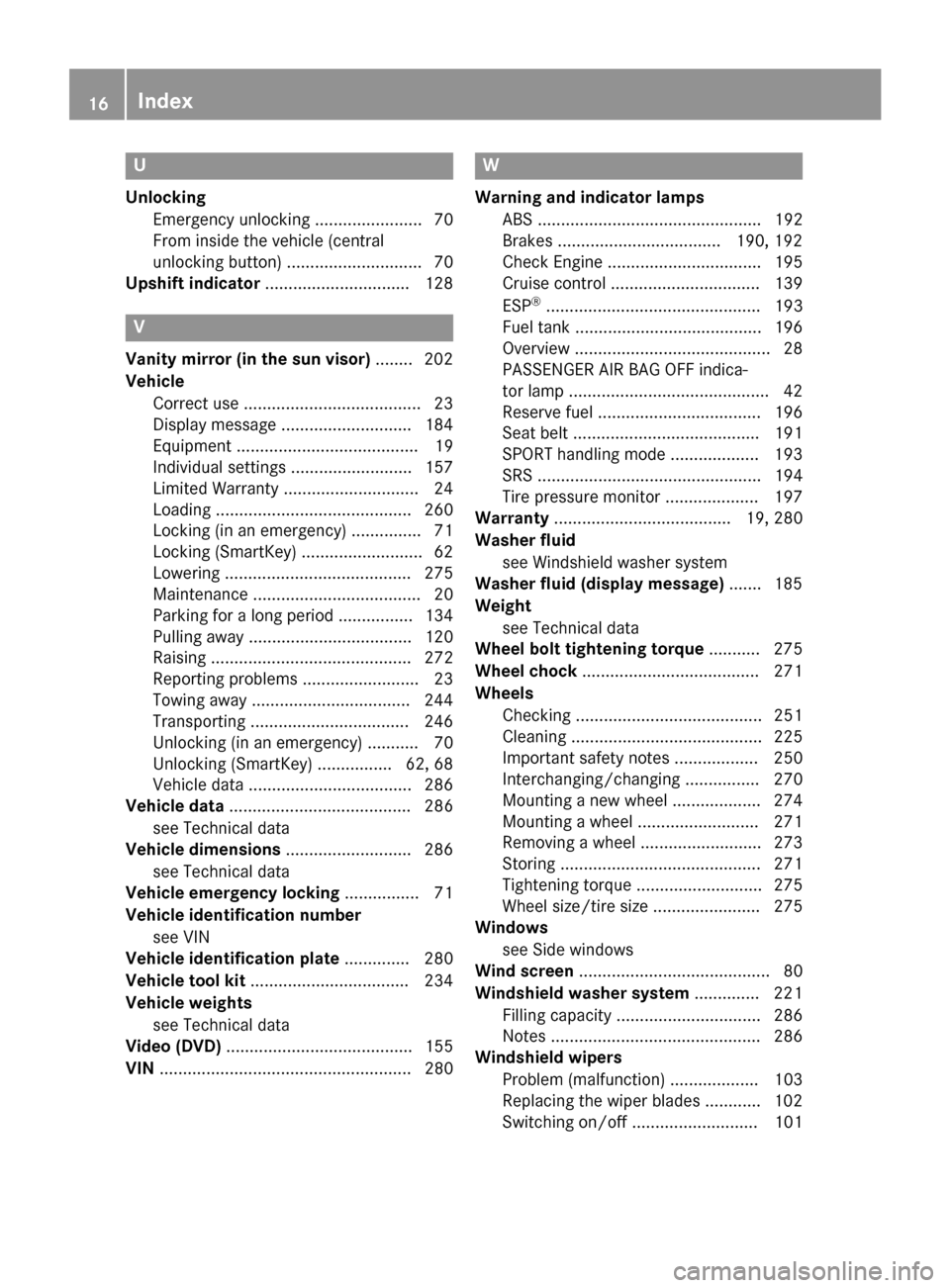
U
Unlocking Emergenc yunlocking .......................70
From inside the vehicle (central
unlocking button) ............................. 70
Upshift indicator ............................... 128V
Vanity mirror (i nthe sun visor) ........ 202
Vehicle Correct us e...................................... 23
Displa ymessag e............................ 184
Equipment ....................................... 19
Individua lsettings .......................... 157
Limite dWarranty ............................. 24
Loading .......................................... 260
Locking (i nanemergency) ............... 71
Locking (SmartKey ).......................... 62
Lowering ........................................ 275
Maintenance .................................... 20
Parking for alon gp eriod. ............... 134
Pulling away ................................... 120
Raising ........................................... 272
Reporting problems ......................... 23
Towing away .................................. 244
Transporting .................................. 246
Unlocking (i nanemergency) ........... 70
Unlocking (SmartKey )................ 62, 68
Vehicl edata. .................................. 286
Vehicl edata ....................................... 286
see Technica ldata
Vehicl edimensions ........................... 286
see Technica ldata
Vehicl eemergenc yloc king ................ 71
Vehicl eidentificatio nnumber
see VIN
Vehicl eidentificatio nplate .............. 280
Vehicl etoolkit.................................. 234
Vehicl eweigh ts
see Technica ldata
Vide o(DV D)........................................ 155
VIN ...................................................... 280 W
Warning and indicator lamps ABS ................................................ 192
Brakes ................................... 190 ,192
Check Engine ................................. 195
Cruise control ................................ 139
ESP ®
.............................................. 193
Fue ltank ........................................ 196
Overview .......................................... 28
PASSENGER AIR BAG OFF indica-
tor lamp ........................................... 42
Reserve fue l................................... 196
Sea tbelt. ....................................... 191
SPOR Thandling mod e................... 193
SRS ................................................ 194
Tire pressure monitor .................... 197
Warranty ...................................... 19, 280
Washer fluid see Windshield washe rsystem
Washer fluid (display message) ....... 185
Weight see Technical data
Wheel bolt tightenin gtorque ........... 275
Wheel chock ...................................... 271
Wheels Checking ........................................ 251
Cleaning ......................................... 225
Important safety notes .................. 250
Interchanging/changing ................ 270
Mounting anew whee l................... 274
Mounting awheel .......................... 271
Removing awheel .......................... 273
Storing ........................................... 271
Tightening torque ........................... 275
Wheel size/tire size ....................... 275
Windows
see Sid ewindows
Win dscreen ......................................... 80
Windshiel dwasher system .............. 221
Filling capacity ............................... 286
Note s............................................. 286
Windshiel dwipers
Problem (malfunction) ................... 103
Replacing the wipe rblade s............ 102
Switching on/of f........................... 101 16
Index
Page 30 of 290

Warning and indicator lamps
Function Page
0043
ESP
® 193
0044
Seat belts 191
0087
Brakes (USA only)
004D
Brakes (Canada only) 0085
High-beam headlamps 98
0083
Low-beam headlamps 97
0084
Turn signal 98
006B
SRS 194
006C
Check Engine
006D
ABS 192 Function Page
006E
Engine oil temperature 150
006F
Tire pressure 197
0070
Electric parking brake (USA
only) 0024
Electric parking brake
(Canada only) 0071
Reserve fuel 196
0072
SPORT handling mode 56
0073
ESP
®
OFF 5528
Instrument clusterAt
ag lance
Page 38 of 290
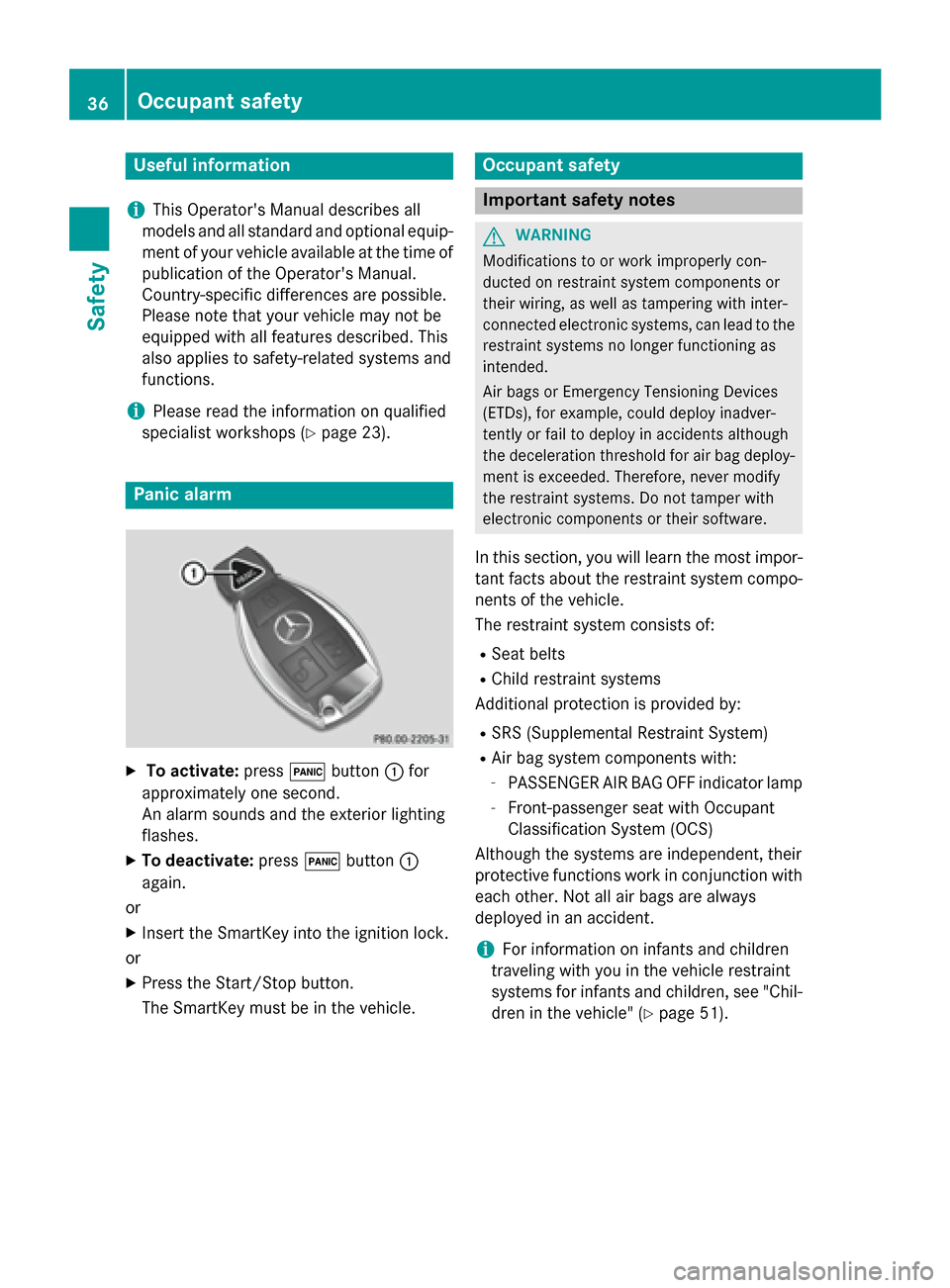
Useful information
i This Operator's Manual describes all
models and all standard and optional equip- ment of your vehicle available at the time of
publication of the Operator's Manual.
Country-specific differences are possible.
Please not ethat your vehicle may not be
equipped with all feature sdescribed. This
also applies to safety-related system sand
functions.
i Please read the information on qualified
specialist workshops (Y page 23).Panic alarm
X
To activate: press0033button 0043for
approximately one second.
An alarm sounds and the exterior lighting
flashes.
X To deactivate: press0033button 0043
again.
or
X Insert the SmartKey int othe ignition lock.
or X Press the Start/Stop button.
The SmartKey must be in the vehicle. Occupant safety
Important safet
ynotes G
WARNING
Modifications to or work improperly con-
ducted on restraint system components or
their wiring, as well as tampering with inter-
connected electronic systems, can lead to the restraint system snolonger functioning as
intended.
Air bags or Emergenc yTensioning Devices
(ETDs), for example, could deploy inadver-
tently or fail to deploy in accidents although
the deceleration threshold for air bag deploy- ment is exceeded. Therefore, neve rmodify
the restraint systems. Do not tamper with
electronic components or their software.
In this section, you will learn the most impor-
tan tfact sabout the restraint system compo-
nents of the vehicle.
The restraint system consists of:
R Seat belts
R Child restraint systems
Additional protection is provided by:
R SRS (Supplemental Restrain tSystem)
R Air bag system components with:
- PASSENGER AIR BAGO FF indicator lamp
- Front-passenger seat with Occupant
Classification System (OCS)
Although the system sare independent ,their
protective function swork in conjunction with
each other .Not all air bags are always
deployed in an accident.
i For information on infants and children
traveling with you in the vehicle restraint
system sfor infants and children ,see "Chil-
dren in the vehicle" (Y page 51).36
Occupant safetySafety
Page 39 of 290

SRS (Supplementa
lRestraint System)
Introduction SRS reduces the risk of occupants coming
into contact with the vehicle's interior in the
event of an accident. It can also reduce the
effect of the forces to which occupants are
subjected during an accident.
SRS consistso f:
R 0075 SRS warning lamp
R air bags
R air bag control unit (with crash sensors)
R Emergency Tensioning Devices
R seat belt force limiters
SRS warning lamp G
WARNING
If SRS is malfunctioning, restraint system
components may be triggered unintentionally
or might not be triggered at all in the event of
an accident with ahigh rate of vehicle decel-
eration. There is an increased risk of injury,
possibly even fatal.
Have SRS checked and repaired immediately
at aq ualified specialist workshop.
SRS functions are checked regularly when
you switch on the ignition and when the
engine is running. Therefore, malfunctions
can be detected in good time.
The 0075 SRS warning lamp in the instrument
cluster lights up when the ignition is switched on. It goes out no later than afew seconds
after the engine is started.
The SRS components are in operational read-
iness when the 0075SRS indicator lamp goes
out while the engine is running. There is
amalfunction if:
R the 0075 SRS warning lamp does not light
up when the ignition is switched on
R the engine is running and the 0075SRS
warning lamp does not go out after afew
seconds
R the engine is running and the 0075SRS
warning lamp lights up again
Safety guidelines for seat belts, Emer-
gency Tensioning Devices (ETDs) and
air bags G
WARNING
R Damaged seat belts or seat belts that have
been subjected to stress in an accident
must be replaced. Their anchoring points
must also be checked. Only use seat belts
installed or suppliedbyana uthorized
Mercedes-Benz Center.
R Air bags and pyrotechnic Emergency Ten-
sioning Devices (ETDs) contain perchlorate
material, which may require special han-
dling and regard for the environment.
Check your national disposal guidelines.
California residents, see
www.dtsc.ca.gov/HazardousWaste/
Perchlorate/index.cfm .
R Air bags and ETDs are designed to function
on aone-time-only basis. An air bag or ETD
that has deployedm ust be replaced.
R Do not pass seat belts over sharp edges.
They could tear.
R Do not make any modification that could
change the effectiveness of the seat belts.
R Do not bleach or dye seat belts as this may
severely weaken them. In acrash they may
not be able to provide adequate protection.
R No modifications of any kind may be made
to any components or wiring of the SRS.
R Do not change or remove any componen tor
part of the SRS.
R Do not install additional trim material, seat
covers, badges, etc. over the steering
wheel hub, front-passenger front air bag Occupant safety
37Safety
Z
Page 40 of 290

cover
,outer sides of the sea tbackrests,
doo rtrim panels ,ordoorfram etrims.
R Do not install additiona lelectrical/elec-
tronic equipment on or nea rSRS compo-
nents and wiring.
R Kee pareab etween ai rbagsa nd occupants
free of objects (e.g .packages, purses,
umbrellas, etc.).
R Air ba gsystem components will be hot after
an ai rbag hasinflated .Donot touch them.
R Neve rplace your fee tonthe instrument
panel, dashboard, or on the seat. Always
keep both fee tonthe floor in front of the
seat.
R Imprope rrepai rworkont he SRS creates a
ris kofr endering the SRS inoperative or
causing unintende dairba gd eployment.
Work on the SRS mus ttherefore only be
performe dbyqualified technicians. Con-
tact an authorized Mercedes-Benz Center.
R For your protectio nand the protectio nof
others, whe nscrapping the ai rbag uni tor
ETD, ou rsafety instructions mus tbefol-
lowed. These instructions are available
from any authorized Mercedes-Benz
Center.
R Given the considerable deployment speed,
required inflation volume ,and the material
of the ai rbags, there is the possibility of
abrasions or other, potentiall ymore serious
injurie sresulting from ai rbag deployment.
If yo uselly ou rv ehicle ,Mercedes-Benz
strongl yrecommends that yo uinfor mthe
subsequent owner that the vehicle is equip-
ped with SRS. Also ,refe rthem to the appli-
cable section in the Operator's Manual. Ai
rb ags
Important safety notes G
WARNING
Air bags are designe dtoreduce the potential
of injury and fatality rate sincertain situa-
tions:
R fronta limpacts (driver's and front-
passenger front ai rbagsa nd knee bags)
R sid eimpacts (head bags and sid eimpact air
bags)
However, no system available toda ycan com-
pletel yeliminate injurie sand fatalities.
Whe nthe ai rbagsa re deployed, asmall
amount of powder temporaril ycome soutof
the ai rbags. Thi spowder generally doe snot
constitute ahealth hazard and doe snot indi-
cate that there is afire in the vehicle .Inorder
to prevent potentia lbreathing difficulties, you
shoul dlea ve the vehicle as soo nasitiss afeto
do so. If yo uhavea ny breathing difficulty but
cannot get ou tofthe vehicle ,then get fres hair
by opening asidew indow or door. G
WARNING
In order to reduce the potentia ldan ger of
injurie scaused during the deployment of the
front ai rbags, the driver and front passenger
mus talway sbec orrectly seated and wear
thei rseatb elts.
For maximum protectio ninthe event of acol-
lision, yo umusta lway sbeint he norma lseat
position with your back against the backrest.
Fasten your sea tbelta nd make sure that it is
correctly positioned on your body. 38
Occupan
tsafetySafety
Page 41 of 290
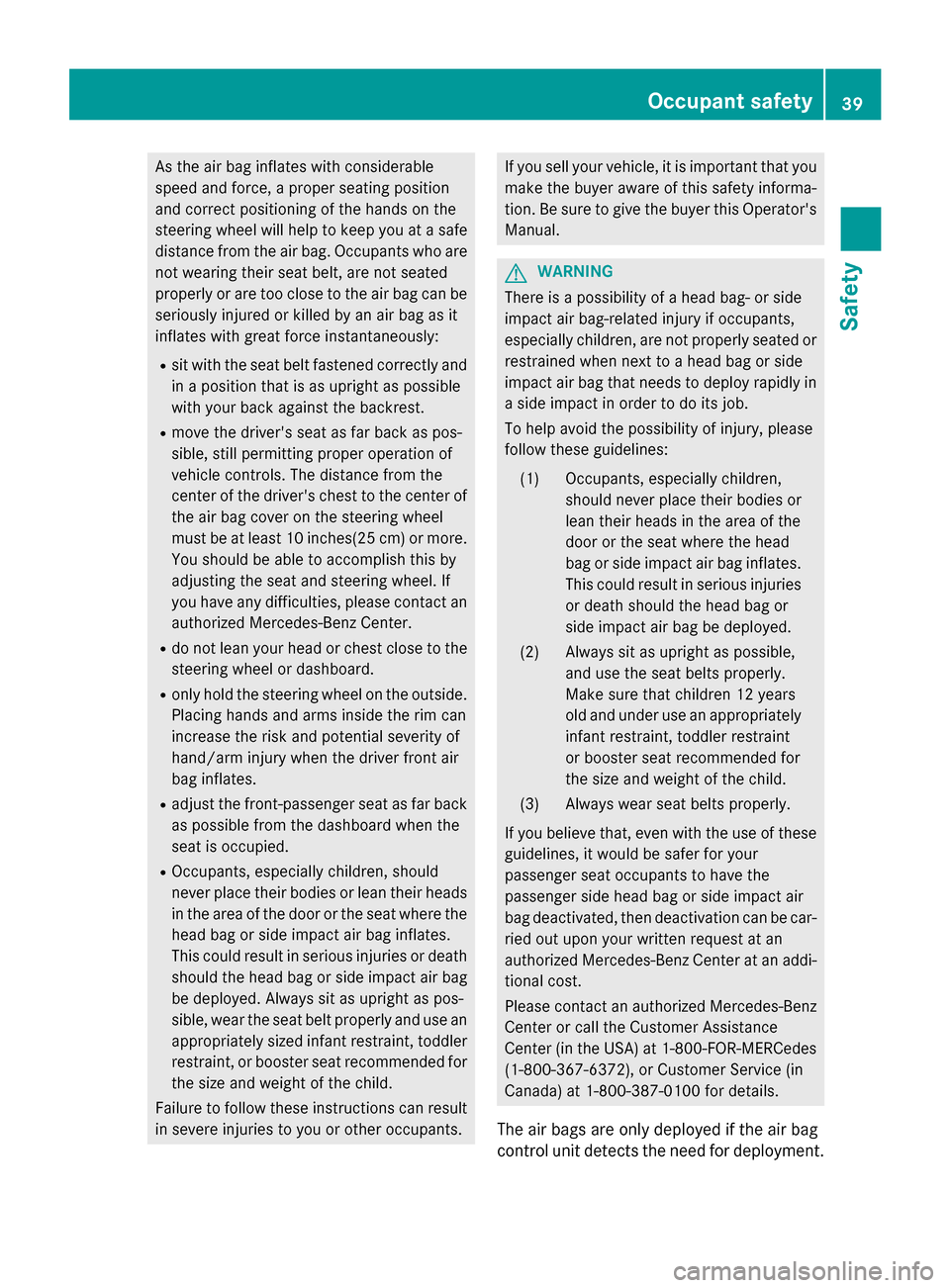
As the ai
rbag inflate swithc onsiderable
speed and force, aprope rseating position
and correct positioning of the hands on the
steering whee lwillh elptok eepy ou atas afe
distance from the ai rbag.O ccupants wh oare
not wearing thei rseatb elt, ar enot seated
properly or ar etoo close to the ai rbag can be
seriously injured or kille dbyanairba gasit
inflate swithg reat forc einstantaneously:
R sitw itht he sea tbeltf astene dcorrectl yand
in ap osit iont hatisasu pright as possible
with your back against the backrest.
R move the driver's sea tasfar back as pos-
sible, still permitting prope roperatio nof
vehicl econtrols .The distance from the
cente rofthe driver's chest to the cente rof
the ai rbag cove ront he steering wheel
must be at leas t10inches(25 cm) or more.
Yo us houl dbea bletoa ccomplis hthisby
adjusting the sea tand steering wheel. If
yo uh avea ny difficulties, please contact an
authorize dMercedes-Benz Center.
R do not lean your hea dorchest close to the
steering whee lordashboard.
R onl yholdt he steering whee lonthe outside.
Placing hands and arms insid ethe rim can
increase the ris kand potential severity of
hand/arm injury when the driver front air
ba ginflates.
R adjus tthe front-passenger sea tasfar back
as possibl efrom the dashboard when the
sea tiso ccupied.
R Occupants, especially children, should
neve rplace thei rbodies or lean thei rheads
in the area of the door or the sea twhere the
hea dbagor side impact ai rbag inflates.
Thi scould resul tinserious injurie sordeath
shoul dthe hea dbagor side impact ai rbag
be deployed .Alway ssitas upright as pos-
sible, wear the sea tbeltp roperly and us ean
appropriately sized infant restraint, toddler
restraint, or booste rsea trecommende dfor
the size and weight of the child.
Failure to follo wthes einstructions can result
in severe injurie stoyouor othe roccupants. If yo
uselly ou rvehicle, it is important tha tyou
make the buye raware of thissafety informa-
tion. Be sure to give the buye rthisO perator's
Manual. G
WARNING
There is apossibility of aheadb ag-ors ide
impact ai rbag-related injury if occupants,
especially children, ar enot properly seated or
restrained when next to aheadb agor side
impact ai rbag tha tneeds to deploy rapidl yin
as idei mpact in order to do its job.
To hel pavoid the possibility of injury ,please
follo wthes eguideli nes:
(1) Occupants, especially children, shouldneve rplace thei rbodies or
lean thei rheads in the area of the
door or the sea twhere the head
ba gors idei mpact ai rbag inflates.
Thi scould resul tinserious injuries
or death shoul dthe hea dbagor
side impact ai rbag be deployed.
(2) Alway ssitas upright as possible,
and us ethe sea tbelts properly.
Make sure tha tchildren 12 years
ol da nd under us eanappropriately
infant restraint, toddle rrestraint
or booste rseatrecommende dfor
the size and weight of the child.
(3) Alway swears eatb elts properly.
If yo ubeliev ethat, eve nwitht he us eofthese
guidelines, it woul dbesafer for your
passenge rseato ccupants to have the
passenge rsideh eadb agor side impact air
ba gd eactivated ,then deactivatio ncan be car-
rie do utupon your written request at an
authorize dMercedes-Benz Center at an addi-
tional cost.
Please contact an authorize dMercedes-Benz
Center or cal lthe Customer Assistance
Center (i nthe USA) at 1-800-FOR-MERCedes
(1-800-367-6372) ,orCustomer Service (in
Canada) at 1-800-387-010 0for details.
The ai rbagsa reonl ydeploye difthe ai rbag
contro lunitd etects the nee dfor deployment. Occupant safety
39Safety Z
Page 42 of 290
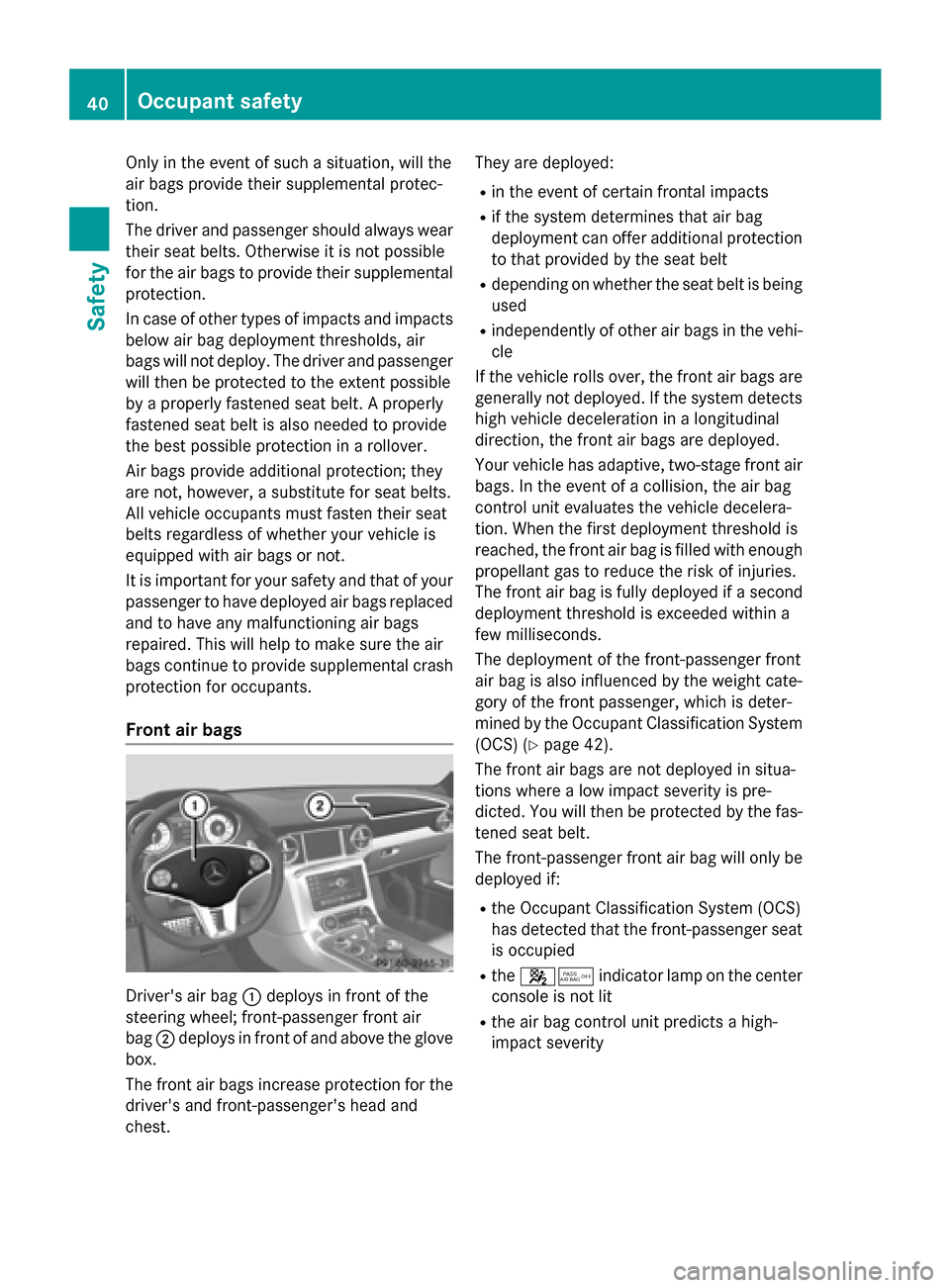
Only in the event of such
asituation, will the
air bags provide their supplemental protec-
tion.
The driver and passenger should always wear
their seat belts. Otherwise it is not possible
for the air bags to provide their supplemental
protection.
In case of other types of impacts and impacts
below air bag deployment thresholds, air
bags will not deploy.T he driver and passenger
will then be protected to the extent possible
by ap roperly fastened seat belt. Aproperly
fastened seat belt is also needed to provide
the best possiblep rotection inarollover.
Air bags provide additional protection; they
are not, however, asubstitute for seat belts.
All vehicle occupants must fasten their seat
belts regardless of whether your vehicle is
equipped with air bags or not.
It is important for your safety and that of your
passenger to have deployed air bags replaced and to have any malfunctioning air bags
repaired.T his will help to make sure the air
bags continue to provide supplemental crash
protection for occupants.
Front air bags Driver's air bag
0043deploysinf ront of the
steering wheel; front-passenger front air
bag 0044deploysinf ront of and above the glove
box.
The front air bags increase protection for the driver's and front-passenger's head and
chest. They are deployed:
R in the event of certain frontal impacts
R if the system determines that air bag
deployment can offer additional protection to that provided by the seat belt
R depending on whether the seat belt is being
used
R independently of other air bags in the vehi-
cle
If the vehicle rolls over, the front air bags are
generally not deployed. If the system detects
high vehicle deceleration in alongitudinal
direction, the front air bags are deployed.
Your vehicle has adaptive, two-stage front air bags. In the event of acollision, the air bag
control unit evaluates the vehicle decelera-
tion. When the first deployment threshold is
reached, the front air bag is filled with enough
propellant gas to reduce the risk of injuries.
The front air bag is fully deployed if asecond
deployment threshold is exceeded within a
few milliseconds.
The deployment of the front-passenger front
air bag is also influenced by the weight cate-
gory of the front passenger, which is deter-
mined by the Occupant Classification System
(OCS) (Y page 42).
The front air bags are not deployed in situa-
tions where alow impact severity is pre-
dicted. You will then be protected by the fas-
tened seat belt.
The front-passenger front air bag will only be deployed if:
R the Occupant Classification System (OCS)
has detected that the front-passenger seat
is occupied
R the 00730074 indicator lamp on the center
console is not lit
R the air bag control unit predicts ahigh-
impact severity 40
Occupant safetySafety
Page 43 of 290

Driver's/front-passenger kne
ebag Driver'
skneeb ag0043 deploys underneat hthe
steerin gcolumn and front-passenger knee
bag 0044underneat hthe glove box .They
deploy together wit hthe fron tair bags .They
are designed to operat etogether wit hthe
fron tair bags in fronta limpact sifcertain
thresholds are exceeded .The knee bags
operat eatbestinc onjunctio nwithc orrectly
positioned and fastene dseat belts.
The driver and front-passenger knee bags
enhance th elevel of protection against:
R knee injuries
R thigh injuries
R lowe rleg injuries
Sidebags G
WARNING
The pressure sensor sfor sid eimpact air bag
contro lare located in th edoors .Don otmod-
ify any component softhedoors or doo rtrim
panels including, fo rexample, th eaddition of
doo rspeakers.
Improper repair wor konthedoors or the
modification or addition of component stothe
doors creat eariskofr enderin gthe side
impact air bags inoperative or causin gunin-
tended air bag deployment. Wor konthe
doors mus tthe refore only be performed by
qualified technicians .Contact an authorized
Mercedes-Ben zCenter. G
WARNING
Only use seat cover swhichh aveb eent ested
and approved by Mercedes-Ben zfor your
vehicle model. Using other seat cover smay
interfere wit horpreventthe deploymen tof
th es idei mpact air bags .Contact an author-
ized Mercedes-Ben zCente rfor availability.
Whe ndeployed ,the sid eimpact air bags offer
additional protection fo rthe thorax of the
vehicle occupant sonthesideoft hevehicle
on whic hthe impact occurs. However, they
do no tprotect the:
R head
R neck
R arms Example: Coupe
Side impact air bags 0043deploy next to the
outer seat cushions.
The sid eimpact air bags are deployed:
R on th esideonw hichani mpact occurs
R at th estart of an acciden twithah ighr ateof
latera lvehicle deceleration or acceleration,
e.g. in asidei mpact
R independentl yofthe use of th eseat belt
R independentl yofthe fron tair bags
R independentl yofthe ETDs
If th evehicle rolls over, th esidei mpact air
bags are generally no tdeployed .The ya re
deployed if th esystem detects hig hvehicle
deceleration or acceleration in alatera ldirec-
tion and determines that sid eimpact air bag
deploymen tcan offe radditional protection to
that provided by th eseat belt. Occupan
tsafety
41Safety Z